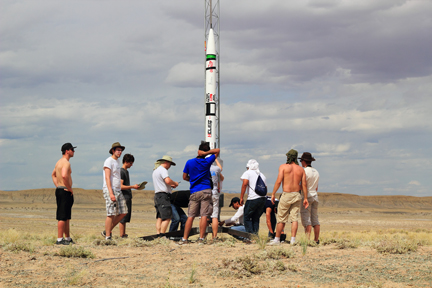Nouvelles
Inaugural flight for Hélios
Third innovative design for Oronos

Last year, after earning their Class 3 permit allowing them to
take part in international competitions, the members of Oronos were filled with enthusiasm and excitement at the idea of
entering their first competition. Hélios, which succeeds the TCMK1 and Everest rockets, was designed with an internal structure
that carries a payload and the engine thrust, and a moveable fuselage to facilitate access to the rocket's internal components.
The prototype, standing 12 feet (3.7 m) high, was equipped with dozens of sensors along its entire length, providing data to
the on-board computer. Made by the members of Oronos, the on-board computer managed the release of the parachutes and of an
aerial brake that would engage near the peak in order to slow the rocket. The team aims to eventually design all the rocket's
components, even the engine. Beyond the design and manufacturing of the fuselage and the internal components, the Oronos
project also includes the manufacturing of the launch pad and the development of a rigorous launch protocol.
A first--and very intense--competition
 Oronos was the only team representing Québec to pit itself against eight other
universities, including only one other Canadian team. The goal of the competition: to launch the rocket so that it reaches an
altitude of 10,000 feet (3,048 m) with the most precision possible while it carries a payload of 10 lb (4.55 kg).
Oronos was the only team representing Québec to pit itself against eight other
universities, including only one other Canadian team. The goal of the competition: to launch the rocket so that it reaches an
altitude of 10,000 feet (3,048 m) with the most precision possible while it carries a payload of 10 lb (4.55 kg).
Hélios was highly successful at take-off, reaching a speed of 985 f/s but unfortunately its trajectory was cut short at 9,500
feet (2,896 m) when the rocket's nose fuselage detached prematurely. Disappointed, the Polytechnique students nevertheless
delivered a strong performance in the oral presentation section, which was presented to the members of the jury and other
competing teams. They earned a mark of 90% for their rocket's esthetic finish and technical aspects. Their innovative aerial
brake, which consisted in deploying three propellers at the base of the rocket to increase the vehicle's drag and slow it down,
also drew great interest from the judges and other teams.
"We'll remember our first competition for a long time to come. While we had mitigated success, the memory of an intense and
enriching experience will remain with us," said Gabriel LaRoche Johnston, the project's general manager. "Since we accomplished
a complete production cycle, from design through construction and finally through deployment, we know we can win this
competition. Next year, we'll compete with two rockets, one in each category--both basic and advanced--and we plan to
incorporate a hybrid motor."

Find out more about Oronos
The Oronos project is emblematic of Polytechnique's leadership in aerospace engineering. The institution is the
first in Québec to offer a bachelor's program in the field. Launched slightly over a year ago, the Oronos project is a
technical society that brings together some 20 future engineers from six engineering specialties who are passionate about
aerospace. This is the first student project of its kind anywhere in Canada. Oronos is devoted to the design and manufacturing
of experimental rockets. The objective is to take part in international university competitions, but also to develop
cutting-edge knowledge in the field of aerospace.
Click here to watch a few videos.



